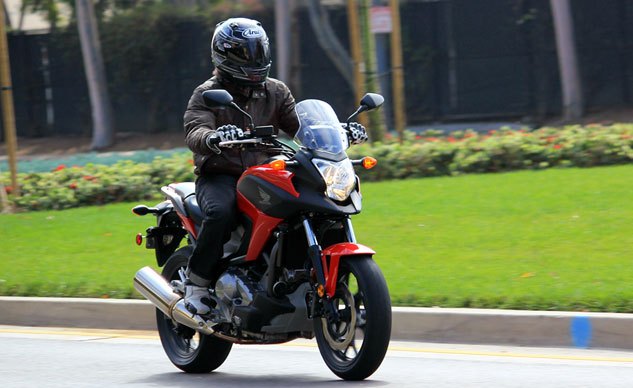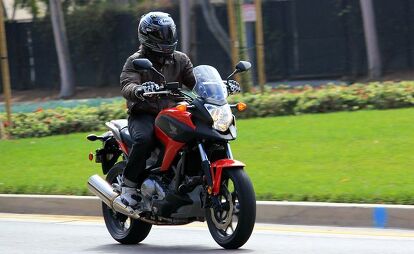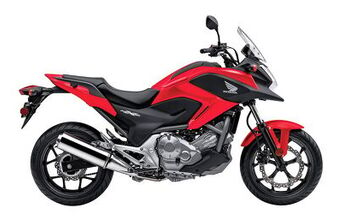2014 Honda NC700X DCT ABS Review

Automatic transmission for the people
When Honda released the 2012 NC700 series of motorcycles with an optional Dual Clutch Transmission (DCT), some members of the riding public scratched their heads. To an experienced rider, operating a well-engineered clutch and gearbox is seen as an asset, not a negative. What the naysayers couldn’t wrap their heads around was that Honda was trying to attract new people to the ranks of riders.
2014 Honda NC700X
| Engine | 16.5/20 |
| Suspension/Handling | 13/15 |
| Transmission/Clutch | 9/10 |
| Brakes | 8/10 |
| Instruments/Controls | 4.5/5 |
| Ergonomics/Comfort | 9/10 |
| Appearance/Quality | 9/10 |
| Desirability | 9/10 |
| Value | 9/10 |
| Overall Score | 87/100 |
2012 Honda NC700X Review – Video
Honda’s engineers made an effort to appeal to seasoned riders, reentry riders, and not-yet-riders by designing a bike with real-world economy and accessible performance. Available in either red or black, the NC700X has thoroughly modern – yet unintimidating – styling that will appeal to many people. Available with a traditional clutch/gearbox, the NC700 is also available with Honda’s second generation DCT to ease the learning curve of new riders.
Since proper clutch control can be a major hurdle to new riders, the dual-clutch tranny eliminates the clutch lever and can provide fully automatic shifting as on some sporty automobiles. Rolling away from a stop requires nothing more than twisting the throttle. In the DCT’s Drive and Sport modes, gear choice is left up to the ECU, with Sport providing quicker responses while using a higher portion of the engine’s rev range. The ECU’s “learning function” monitors the engine to determine the riding environment (throttle and gear positions, speed, etc.) and anticipate what action will be required next, allowing the shift points to vary within the same mode.
For times when more rider involvement is desired, Honda’s DCT has given the rider the ability to temporarily override the DCT with the shift paddles on the left grip. A short period after utilizing the shift paddles to select a gear, the Engine Control Unit (ECU) will return to the automatic mode. As a rider’s experience level increases, the DCT’s paddle-shifting manual mode gives more control and can be easily engaged via a switch on the right handgrip.
While the DCT’s Drive mode is focused on user-friendly performance and fuel economy, rolling on the throttle still moves you past traffic without drama. Whacking the throttle open causes a quick downshift (or two) to occur before strong acceleration begins. In order to avoid the shifting delay after the throttle is opened, experienced riders will prefer to preemptively override the DCT by downshifting manually and thus shortening the reaction time significantly. Sport mode changes the gear selection, and downshifts come sooner, giving the benefit of a little engine braking entering corners. Experienced riders will grin as they thumb a couple quick downshifts on corner entry, roll on the throttle, and let the DCT do all the upshifting work. With the DCT arrangement, changing gears is amazingly seamless.
Motorcycle Beginner – Year 2: 2013 Honda NC700S Review
The smooth fuel metering from the NC700X’s EFI supplies both fun and practicality. The power delivery is tuned to get the most bottom end and mid-range from the 670cc parallel-Twin. Torque comes immediately off idle and peaks at 4750 rpm with 44 ft-lb, as recorded on the dyno during our comparo of the non-DCT version against Kawaski’s Versys. Horsepower weighs in at a relatively sedate 47.6 hp at 6250 rpm.
Fuel efficiency was designed from the inside out, beginning with the friction-reducing coatings on the walls of the cylinders, each carrying an undersquare 73mm bore and 80mm stroke. The intake and exhaust ports branch within the cylinder head, enabling the use of a single 36mm throttle body. Engine compactness is improved through a camshaft-driven water pump and the centralized location of the catalytic converter. In addition, special attention was paid to making the mill as compact and light as possible.
To achieve the desired mass centralization, the engine’s two parallel cylinders are canted forward 62-degrees to make it shorter and flatter. Honda filled the space normally reserved for the gas tank with a handy, waterproof compartment large enough to hold some (but not all) XL full face helmets.
Out on the interstate, the engine turns a comfortable 3500 rpm at 65 mph. Engine vibration is minimal, starting around 4500 rpm. In our somewhat greedy hands, the NC yielded an average fuel economy of 54.9 mpg for a mathematical range of 203 miles from its 3.7-gallon tank located under the seat, low and forward next to the engine.
Around town, the NC700X feels balanced and stable. The rider’s upright position is perfect for negotiating traffic. Thanks to the wide handlebar, steering response is immediate and predictable. The Bridgestone BT-023 tires offer plenty of grip given the NC’s job description. While the styling and long-ish-travel suspension (5.4 inches front and 5.9 inches rear) may look like they’re ready for light off-road use, the NC has no such aspirations but is more than capable at handling the road irregularities found in the concrete jungle. The soft front end dives under the initial application of brakes, but not excessively so. As long as the pace is kept within the parameters for which the suspension was designed, it works well, though mid-corner bumps do occasionally upset the chassis.
As part of the DCT package, Honda’s Combined ABS links the front and rear calipers to the brake pedal. When the pedal is depressed, the rear brake is activated and a proportioning valve varies the percentage of power delivered to the front wheel’s 320mm disc in an effort to optimize the use of both brakes. Lightly applying the brake pedal feels as if the proportioning valve is initially only sending power to the 240mm rear, but increasing the pedal pressure causes the front end to dive slightly, reflecting the effects of both brakes being utilized. The front brake is controlled independently by two of the caliper’s three pistons. ABS kicks in if either wheel reaches a threshold for impending lockup. While not as powerful as more sporting brakes, they are more than capable of getting the job done with a firm pull at the lever.
The bike feels much lighter than the claimed ready to ride weight of 505 lbs which can be attributed largely to the NC700X’s extremely low CG, thanks to the engine’s inclined cylinders and the low position of its fuel tank. Although the 32.7 in. seat height may give shorter riders pause, the narrowness of the bike combined with its low CG keeps the NC700X from feeling top heavy.
The NC700X’s fashionable styling and fit and finish doesn’t look like that of a motorcycle whose base price is $8,799. (If you’d rather have a traditional transmission and no ABS, the price drops $1,000.) Honda has managed to deliver a great combination of fun and efficiency at a reasonable price – even with the cool DCT/ABS technology.
The NC700X delivers a good value for the money – one new and reentry riders should take a serious look at.

Like most of the best happenings in his life, Evans stumbled into his motojournalism career. While on his way to a planned life in academia, he applied for a job at a motorcycle magazine, thinking he’d get the opportunity to write some freelance articles. Instead, he was offered a full-time job in which he discovered he could actually get paid to ride other people’s motorcycles – and he’s never looked back. Over the 25 years he’s been in the motorcycle industry, Evans has written two books, 101 Sportbike Performance Projects and How to Modify Your Metric Cruiser, and has ridden just about every production motorcycle manufactured. Evans has a deep love of motorcycles and believes they are a force for good in the world.
More by Evans Brasfield







































Comments
Join the conversation
One of the best damn bikes in the market that has broken sales records globally for a reason. Truly lives up to the hype and is made for real riders, not journalists.
Ria Tony | sell my motorcycle
Since when does a bike review say NOTHING about seat comfort, ergonomics, engine sound, wind protection, heat levels from the radiator, or maintenance intervals??? Chain drive sucks, don't let anyone fool you! I've seen these NC700's for sale used, with corbin seats, so the stock seat must suck as well, add $400 for a different seat. And the resale value is dropping like a stone for some reason. Good luck adjusting the valves yourself, or pay a 'stealer' hundreds of dollars to do it for you. I've had ABS on a BMW, if and when the ABS pump starts leaking it's $1800 for a rebuilt one. So much for economy. And try changing a fuel filter on a fuel-injected bike! Ah, the price of progress. I ride a sportster with an auto-clutch (the stock clutch was ridiculously stiff). Harleys do it for me: Real steel parts, beautiful castings, excellent finish, American styling, great fuel mileage, belt drive, rubber mounted engine, superb sound, excellent torque, fine handling, very little noticeable engine heat, excellent seats and ergonomics, and a huge bargain-priced used market for parts and accessories. Do yourself a favor, try a modern Harley Davidson.